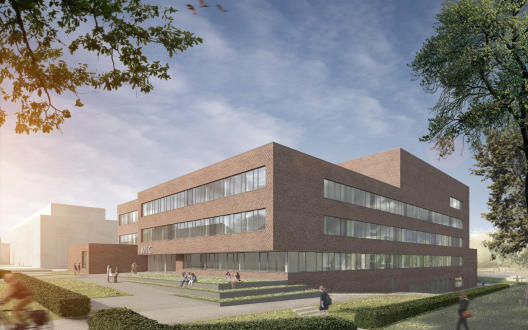Building work begins on the Multiscale Imaging Centre

Next Monday, 16 January 2017, sees the beginning of building work for the new Multiscale Imaging Centre (MIC), a research building in Münster University’s Natural Science Centre in Röntgenstraße. In future, University researchers will be bringing together here a broad spectrum of biomedical imaging processes to be used in studying the behaviour of cells in organisms. The Bau- und Liegenschaftsbetrieb NRW (Building and Real Estate Management Authority for North Rhine-Westphalia) is undertaking the 63 million euros project on behalf of Münster University. The technically ultramodern building is due to be completed by the middle of 2019.
Using microscopes and tomographs, researchers at Münster University’s Cells-in-Motion Cluster of Excellence already produce images every day which provide a better understanding of cellular processes in both healthy and diseased organisms – from the individual cell and its components to tissue and entire organs. This method of generating images of structures in a variety of magnitudes – known as multiscale imaging – is what gives the MIC its name. “Having our own building gives us the structural basis for the long-term establishment of the Cluster of Excellence research concept at Münster University,” says Prof. Michael Schäfers, the MIC spokesman. The new research centre will bring experts from a variety of faculties even closer together.
The research centre is to be built in Röntgenstraße, in the immediate vicinity of the Max Planck Institute for Molecular Biomedicine and the Centre for NanoTechnology (CeNTech). The new building housing the imaging equipment requires special precautions to be taken, for example for a microscope which is especially sensitive to vibrations. In addition, precision cold and steam generators will also need to be housed here, and a particle accelerator will require special shielding measures.
The building was designed by the Gerber Architekten practice in Dortmund. Around 260 people will be undertaking research together under one roof, on a main usable area of around 5,700 m². The design provides for a square building with three to five floors, containing laboratories, offices and seminar rooms. The different number of floors is a result of the sloping terrain and takes account of the adjacent buildings. The outside impression of the compact, tiered structure will be dominated by a splendid entrance area, broad window hinges and a brick clinker façade typical of the region.
The building costs will be borne by the Federal Government in Berlin, the state of North Rhine-Westphalia and Münster University. Berlin and North Rhine-Westphalia had agreed on the construction of the research centre in June 2014 after a corresponding recommendation from the German Council of Science and Humanities.

